L-E-V from Israel and Dorrance Dance debut at Jacob’s Pillow, July 24-28.
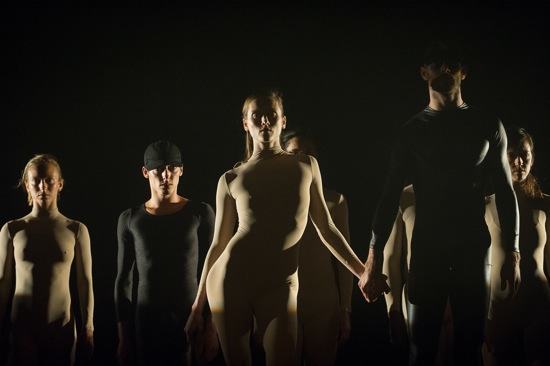
L to R: Olivia Ancona, Gon Biran, Rebecca Hytting, Douglas Letheren, and (half-hidden) Rachael Osborne in House. Photo: Christopher Duggan
Who are these creatures emerging from smoky dimness? Ghosts? Robots? Ghosts of robots? They can move in tiny jerks or so fluidly that they appear boneless—pale, androgynous, undulating figures assembling for. . .what?
Viewed from another perspective, they are the stunning members of L-E-V, a dance company founded in Israel earlier this year by Sharon Eyal and Gai Behar, and they are performing the pair’s House at Jacob’s Pillow.
Introducing the group’s U.S. debut in her usual opening speech in front of the stage curtain, Pillow director Ella Baff mentions that the ancient Hebrew word lev means heart. Don’t expect to see much tenderness or love in House. Think instead of “Put your heart into it.” That is, your complete mental and physical energy and focus. And given Ori Lichtik’s assaultive electronic score for the piece (played from backstage), the word “house” could also refer to the house music heard in clubs (Behar has produced techno raves, as well as other far-out music and art events). Too, one can mull over the fact that a version of House was performed in a deserted former leper hospital in Tel-Aviv, where the rooms and corridors summon up images of vanished inhabitants.
The first production of House was presented in 2011 by Batsheva Dance Company, in which Eyal was a performer and then a resident choreographer; all the current members of L-E-V danced either with BDC or with its second company, Batsheva Ensemble. In the piece’s movement style, you can see the influence of Gaga, the movement language and training technique created by Ohad Naharin, Batsheva’s artistic director. For a dancer, Gaga involves developing a hyper-awareness of how his/her body works—skin, muscles, the tiniest of joints, the gradations in tension and relaxation. In the resultant multi-tasking body, a movement can be initiated anywhere and flow out in several, constantly changing directions.
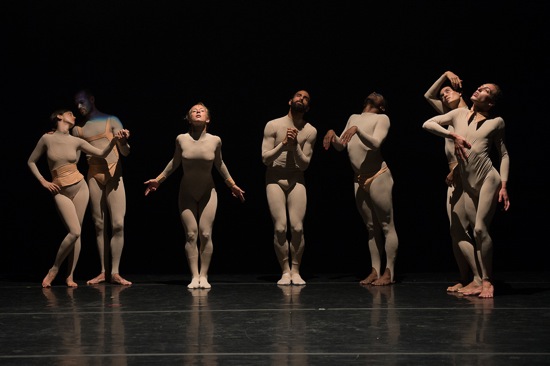
Sharon Eyal and Gai Behar’s House. L to R: Ya’ara Moses, Douglas Letheren, Olivia Ancona, Tom Weinberger, Léo Lérus, Rachael Osborne, Gon Biran. Photo: Christopher Duggan
House begins as the house lights in the Ted Shawn Theater fade to black and an increasingly dense chatter of male voices from several speakers surrounds us. The curtain opens to reveal a smoky stage with a dim, tent-like area of light at the back (the eerie lighting is by Avi Yona Bueno, aka Bambi). From the depths, a figure appears, encased in a shirred, shiny black leather (?) suit, its feet in black socks. This slim, long-legged creature (it is Eyal) establishes the movement vocabulary that the members of her tribe will share. Insect-like, she prowls the stage, curling her spine forward and then arching it back, snaking her hips in one direction and her ribcage in another. She spreads her legs wide and bends them deeply. As she steps, her knees occasionally wobble and keel toward each other. Her hands may dangle like paws or claw the air. Occasional jerks and pauses occur, but within an overall twisting, spiraling stream of movement.
The dancers who enter behind her wear flesh-colored unitards, each individualized by pink accessories—a belt here, a jockstrap there (attire by Ma’ayan Goldman). Later, they will reappear in outfits like Eyal’s. As the voices fade and a powerful percussive beat, accompanied by various electronic effects, takes over, the clump of eight dancers separates for a while into a line of four, a trio, and a soloist. The image of soloist and back-up group recurs, but never in the standard performance relationship; you simply see the counterpoint as various activities happening within a single village. Olivia Ancona emerges from the group, as does Gon Biran; later Rachel Osborne shows herself off downstage, aware of the audience.
The dancers all seem to focus on things we can’t see, turning their heads here and there, often in opposition to where their feet are taking them. They don’t travel much through space, though; once onstage, they stay close to one spot, the insistent percussive sounds abetting the feeling of constriction. It becomes clear before long that Eyal is going to maintain a high level of energy that demands endurance from the audience, as well as from the performers.
Images of human relationships and atmospheres flicker into existence and vanish. Ya’ara Moses strokes her body, shakes her hair loose, throws her head around. Douglas Letheren comes up behind her, puts his arms around her, and rubs her groin rapidly. He yells something. From the darkness at the back, a naked woman (Rebecca Hytting), appears, walking slowly forward on high-heeled silver shoes, and attended by Letheren in a black outfit and platform shoes (this could allude to a fashion-show runway, but without the clothes and the strut). Meanwhile, four ascending musical notes repeat over and over, and bands of lights from the sides of the stage hit the dancers’ knees. When Hytting and Letheren have moved downstage, away from the slo-mo quartet of dancers behind them, he reaches a hand out to her, thumb up; she sucks it. Osborne interrupts her solo to put her hand on Hytting’s groin and glance at us.
These flashes of behavior sometimes occur simultaneously. How are we to interpret Letheren and Biran taking turns picking each other up the way you’d cradle a child, while Léo Lérus, now behind Hytting, puts his hand around her throat and pulls her head back? Why, when everyone is moving in unison, does Tom Weinberger continue his own dance, off to the side, sometimes opening his mouth in a silent yell? What do the dancers intend when they stick their tongues out Images fly by briefly, teasingly, as if promising full disclosure at a later date.
No move these people make looks exactly like something you’ve seen before. Strong, beautiful, possibly doomed and unaware of that fact, they’re in a snake pit all their own—A couple of leaps following the quite formal final dance for two interpenetrating lines of performers comes as a surprise. This is an earthbound tribe.
So controlled are the performers that it’s almost shocking to see them during the many curtain calls and standing ovation. Smiling, waving, shrugging, straggling forward, they look like folks you instantly want to invite to a picnic. Now they give you permission to love their humanness, in addition to admiring them for the pummeling they’ve been giving your sensibilities for the past hour.
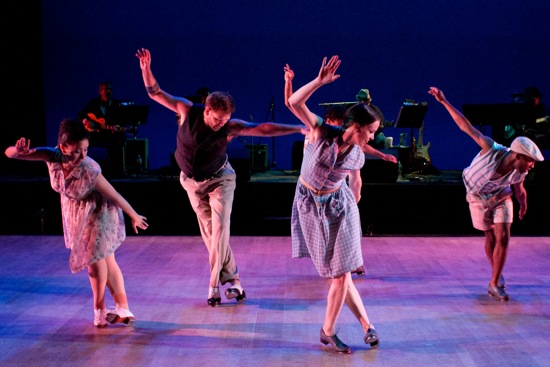
Michelle Dorrance, front, in her The Blues Project, with, L to R: Claudia Rahardjanoto, Nicholas Van Young, and Byron Tittle. Photo: Em Watson
While L-E-V is packing them into the Ted Shawn Theatre, Dorrance Dance is filling the Pillow’s Doris Duke Theatre down the hill. The two performances couldn’t be more different. Michelle Dorrance’s ensemble of superb tappers and musicians makes you feel that if they can create intricate rhythms with their feet while keeping their balance in a shifty world, we can survive too. The music composed and performed by Toshi Reagon for The Blues Project may reference woeful themes from the dark history of this country, but the message is joy in the dancing, joy in being alive.
Having seen Dorrance Dance perform last January in the deep space of Danspace St. Mark’s, I was worried by the set-up in the theater. A platform for the musicians—two or more feet high—stretched across the black-box space and ate up a good portion of the depth. The resonant floor at the front was shallower than usual. My worry was pointless. Dorrance is skilled at designing patterns to fit whatever dimensions confront her. As skilled as she is at building a program and keeping the momentum going.
The musicians, lined up along the platform, hold their peace for a short while, except for percussionist Allison Miller, who supplies a modest boom-chick beat. Time to take them in during the seconds before the dancers enter. Behind and above the dancing floor, sit Miller, Adam Widoff (electric guitar), Juliette Jones (violin), Fred Cash (bass), and, in the middle Reagon herself. The dancers step into view noiselessly, criss-crossing the stage individually or in small groups. You wait; any minute, the feet will get very busy, and so will the musical instruments.
Now you get to meet almost all the terrific dancers. Lighting designer Kathy Kaufmann lays a fan of light rays on the floor, and Jones hops off the platform to chivvy the dancers along with her violin skills. They gather gradually and cluster around, the women in pretty, mildly retro summer dresses, the men in trousers and vests. Some are barefoot—looks like a country gathering, an impromptu hoedown. Here’s Karida Griffith and Byron Tittle. Welcome, Christopher Broughton and Nicholas Van Young. Take a solo, Elizabeth Burke, you got the shoes for it. Hey there, Derick K. Grant and Claudia Rahardjanoto. Pretty soon, everyone jumps in unison and Van Young finds a washboard he can scratch.
Things start getting complex pretty quickly. For one thing, Reagon unleashes her wondrous, deep-souled voice; the barefoot dancers put on their tap shoes. As the hour-long dance unwinds, you can appreciate how astutely Dorrance manages the flow. Patterns break and re-form. Performers start a number, others wander in and join them, or replace someone who has strolled away. The atmosphere is convivial, rarely competitive.
Dorrance performs her first solo to Reagon’s quiet guitar picking and a plaintive song that references Big Bill Broonzy’s country blues, “Mr. Conductor.” Dorrance (who won this year’s Jacob’s Pillow Award) begins softly too. What’s particularly entrancing is the contrast between her lanky, slim-jim body and easy-going manner and her feet’s precision. She can stagger and make her legs go rubbery, while from the ankle down, she’s still conversing articulately with the floor. Those heels and toes can whisper, jabber, hammer, skid, brush, and more with carefully modulated dynamics. Her feet aren’t always under her either; she can take strides so big you think she may slide into a split (something Tittle later does). Or she can get in a spot-lit corner and give that floor the business.
And somehow, her tapping and Reagon’s singing meld affectingly, even though the latter ends by herself with a high, repeated begging, “Please, please, please, please. . . .”
In a gracious program note, Dorrance honors Reagon’s blend of folk, blues, and spiritual with a revolutionary approach, and also asserts her admiration for Grant and Dormeshia Sumbry-Edwards as “cutting edge hoofers,” who also have longer histories in tap than she does.
Sumbry-Edwards is indeed a master. In The Blues Project, she calmly taps rhythms so clear and so intricately textured that you can close your eyes and imagine that this beautiful woman has four legs. Grant, a big man, focuses intently on what his feet are doing, suspending their activity sometimes to skid or gallop along, and then digging down into the complexity he’s creating. When the two of them work together a while, the others circle them with a little dancing frame. “Sweet everlasting. . .” sings Reagon, and it is.
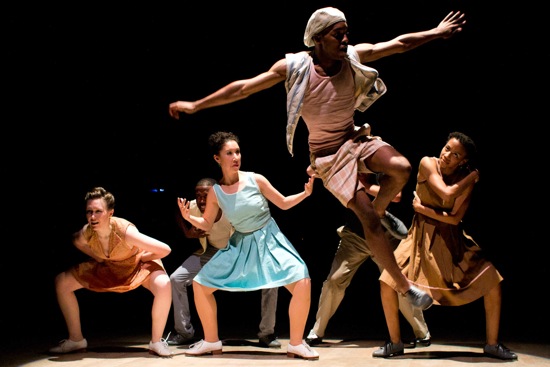
Byron Tittle takes off for (L to R): Elizabeth Burke, Claudia Rahardjamoto, and Karida Griffith. Concealed In back: Christopher Broughton and Nicholas Van Young. Photo: Em Watson
There are bits of byplay and show-off stuff. Van Young gets his hands into the act, with slapping and clapping rhythms. At one moment, he pushes his way in front of four dancers and holds them back. He could be trying to take over (a bit of showing off by all concerned ensues), but it also looks as if he’s holding them back from falling off a cliff. But. At some point Burke, Griffith, and Rahardjanoto reappear in fresh dresses, with Dorrance in gray slacks and shirt. Everyone has changed into sneakers. Here comes a snatch of the Lindy. We’re in the city now, for sure. What say someone flips the choreographer?
Dorrance makes sure we focus on each of these dancers—so that we can appreciate, say, how lusty Broughton is and how elegantly cool Griffith. By the time they all whip into some final unison tapping, we can feel we know them all.
To have the musicians onstage, playing and responding to what they see, is a delight. They weave a texture, emphasize a rhythm, buoy up the dancing on a sensitive sea of sound. At one point during Dorrance’s first solo, I notice that drummer Miller, temporarily unoccupied, is nodding her head and grinning in pure pleasure, as if she can’t get over the inventive stuff this gifted, on-the-move dancer-choreographer is coming up with. I’m with her.

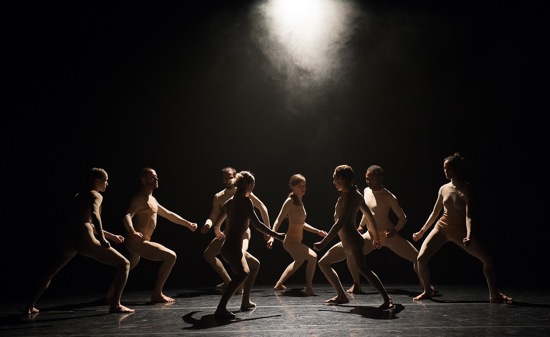
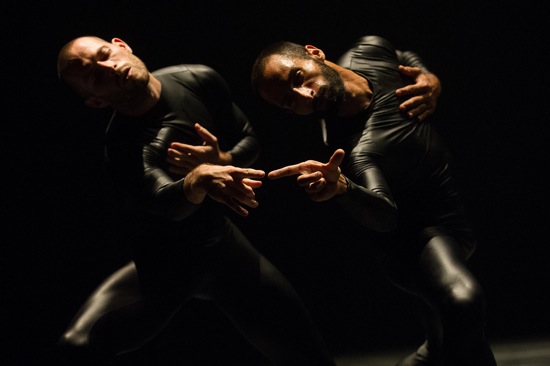
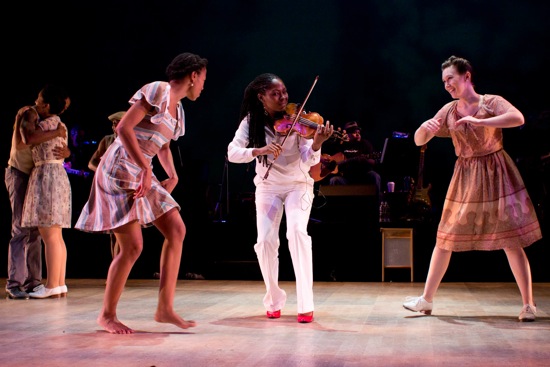
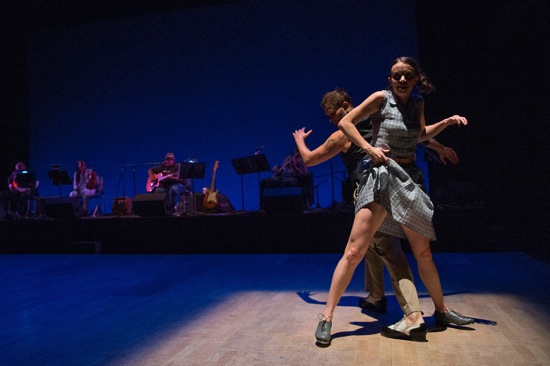
Dear Deborah
I highly enjoyed this review depicting so succinctly, and “getting to the bone and marrow” of the two companies you wrote about in your fine review. You captured so well the uniqueness of each company, who indeed, could not be more different.
Also, I never heard before a more precise and delicious verbal description of Gaga.
Thank you: I could’t be there to see LEV – which as a word – is also a contemporary Hebrew word for HEART.
After reading your piece I felt as as if I saw them.